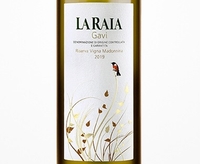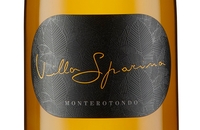And indeed, Italy does seem to have more than its share of fresh whites that don’t really profit from aging. It’s a bit of a chicken-or-the-egg scenario: have drinkers learned the hard way that white wine beyond on a certain age is probably past its sell-by date, or do winemakers not invest in making more age-worthy wines because there’s little interest in such wines among their consumers?
There are any number of exceptions, of course, both in the form of individual producers – the Trebbianos of Valentini, for example, or regions where producers have collectively found their local grapes capable of making wines that enjoy some time in the cellar. In Piedmont, a handful of Gavi producers have demonstrated that wine’s ability to age in the bottle.
The Gavi DOCG lies in the southeast corner of Piedmont, close to Liguria. It is the sole DOC or DOCG in the region dedicated solely to white wine, and many of its producers are similarly focused; Gavi is not a sideline or cash cow white as fresh white wines can be in other areas. Its origins are humble: for a long time the local Cortese grapes were used to create base wines for Turin’s vermouth producers. The Gavi Consorzio will celebrate its 30th anniversary next year, however, as well as the 25th anniversary of the DOCG, and producers have used that time well.
The production region can be divided into three sections. The warmest is also the most northerly, and the warmth shows in wine’s body, which can be rounder and weightier than those from further south. The central area is home to the appellations two crus, Monterotondo and Rovereto, and is a focal point for well-structured, age-worthy specimens. The narrow southernmost area reaches higher elevations as it stretches into the Appennines; plantings are scattered for now, but this area may see further exploration as growers respond to climate change.
Typical Gavi wines can be lean, citrusy, and saline in their youth, and somewhat neutral in character; with its high acidity one can see why officials identified Cortese as well-suited to sparkling wine production back in the nineteenth century. The wines broaden with age and often develop a beeswax or kerosene note. It’s a transformation somewhat reminiscent of Hunter Valley Semillon, with a panoply of spice notes replacing the toastiness found in those Australian wines. Production techniques are more varied, however, which makes sense given the greater number of producers.
Here are some recommended wines from a recent tasting held in New York City: a mix of aged examples but also few current releases – one must start somewhere if one hasn’t been laying down Gavi in the cellar already. If you choose to do so, it may put you well-ahead of your Italian friends; 85% of Gavi is exported. Yet another reason Italian wine drinkers may lag behind in getting excited about aged white wine.
The Wines:
 La Raia Gavi Riserva “Vigna della Madonnina" 2019: Shows notes of lime, flint, and just a hint of spice. Light-bodied and high in acid, with a definite saline character. Made from 60-year-old vines, the wine spends 18 months in tank before bottling, so this wine will seem “old” to the uninformed even on its release, but the tension and life in the wine belie that premise.
La Raia Gavi Riserva “Vigna della Madonnina" 2019: Shows notes of lime, flint, and just a hint of spice. Light-bodied and high in acid, with a definite saline character. Made from 60-year-old vines, the wine spends 18 months in tank before bottling, so this wine will seem “old” to the uninformed even on its release, but the tension and life in the wine belie that premise.
Tenuta la Giustiniana Gavi “Montessora” 2018: Made in a somewhat riper, rounder style and showing more fruit – nectarine, kumquat, and gooseberry. A little bit of waxiness has already begun to show, too.
Broglia Gavi “Bruno Braglia” 2018: Broad on the palate, but well-structured. Shows some stone fruit notes and a hint of beeswax.
Broglia Gavi “Bruno Braglia” 2013: A tremendously interesting wine which has likely reached the full potential of its time in bottle. The mineral, petrol, and beeswax notes predominate, but fruit – lime and clementine – are still present. The spice touch is subtle, leaning towards saffron, and the wine’s finish is long and elegant.
La Mesma Gavi “Vigna della Rovere Verde” 2016: Medium bodied and firm on the palate, with notes of nectarine and tangerine. Pleasantly textured and elegant.
La Zerba Gavi “Terrarossa” 2016: Shows a pleasant balance between ripe tree fruit and spice. Quite muscle-y, firm, and dense on the palate.
 Villa Sparina Gavi “Monterotondo” 2014: The Villa Sparina wines have aged well, but stands out from the rest of the lineup because of the winemaking. Gavi was not spared the enthusiasm for aging white wine in new French oak barriques that swept the world a few decades ago, and Villa Sparina was the appellation’s leading proponent. Setting aside that stylistic question the wines are extremely well-made, and the oak and fruit have integrated nicely. The 2014 shows notes of ripe peach, lemon curd, and orange marmalade alongside honey, beeswax, and hazelnut touches. It’s a big wine, but still structured, with good supporting acidity.
Villa Sparina Gavi “Monterotondo” 2014: The Villa Sparina wines have aged well, but stands out from the rest of the lineup because of the winemaking. Gavi was not spared the enthusiasm for aging white wine in new French oak barriques that swept the world a few decades ago, and Villa Sparina was the appellation’s leading proponent. Setting aside that stylistic question the wines are extremely well-made, and the oak and fruit have integrated nicely. The 2014 shows notes of ripe peach, lemon curd, and orange marmalade alongside honey, beeswax, and hazelnut touches. It’s a big wine, but still structured, with good supporting acidity.
Villa Sparina Gavi “Monterotondo” 2010: Not as opulent as its younger sibling, with good structure. Shows more ripe tree fruit – apricot and nectarine, alongside the expected beeswax and baking spice notes.
Villa Sparina Gavi 2021: Medium-bodied and dense, with mineral and lemon notes. A little austere in its youth, but still enjoyable, and will develop with time even if it is “only” the regular wine rather than the prestigious Monterotondo bottling, above.
Tenuta La Giustiana Gavi “Montessora” 2021: Medium-bodied, mineral and saline, with some spice notes and yellow plum fruit.
Piccolo Ernesto Gavi “Rovereto” 2021: I really enjoyed the muscle and vibrancy of this wine; it has great presence on the palate. Shows Meyer lemon, mineral, and salty notes at present.
Biné Gavi 2021: Expressive, with citrus and spice notes. Light bodied and fresh.
Biné Gavi “11” 2021: Made from a single block on the property, the 11 shows more floral and tree fruit notes. It also sports more structure and body, but is still quite fresh.
Connect with Jim on Twitter: @JimWineBeer
